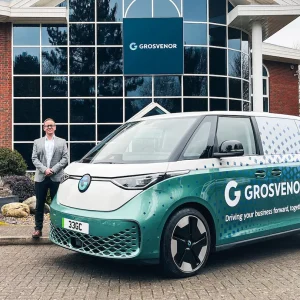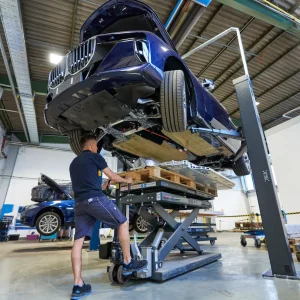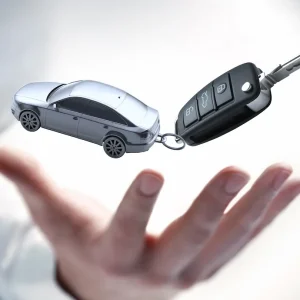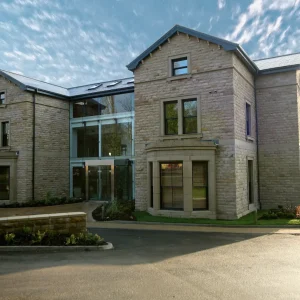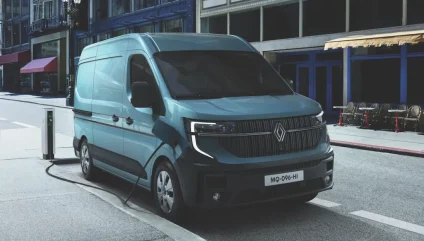
Renault rose to prominence in the electric van market more than a decade ago with the development of the groundbreaking Kangoo Z.E, which was succeeded by the equally well-received Kangoo E-Tech.
Following its pioneering work in the compact van sector, the brand is set to reinforce its position as the pre-eminent electric van manufacturer with the introduction of the new Master E-Tech large van.
Going from strength to strength
Alongside the Kangoo E-Tech and medium-sized Trafic E-Tech, the new Master E-Tech completes a highly competitive electric van line-up for Renault.
New from the ground up, Master E-Tech represents a huge step up from its predecessor in terms of range, efficiency and sophistication and is set to build upon the strong position the diesel-powered Master has established in the global large van sector. To make the transition from ICE to BEVs easier for customers, diesel and electric versions of the Master are produced on the same platform, with both sharing the same dimensions and loading capacities.
New design and technology
With its imposing new front end featuring Renault’s new logo, Master E-Tech is a
head turner on the road but the van’s striking design makes more than a visual impact.
Renault has improved the aerodynamic efficiency thanks to testing and designing the new Master in a wind tunnel built to assess aircraft.
This has led to improvements to the exterior design, including shortening the bonnet, tilting the windscreen and moving it forward, streamlining the wing mirrors, air-intake ducts in the bumper and the slope of the roofline and narrowing the rear of the vehicle.
Power, range and efficiency
To suit the mileages customers cover during their working schedules, Renault offers
Master E-Tech in a large 87kWh battery, which is accompanied by a 140hp (105kW) electric motor and produces up to 300Nm of torque. This gives Master E-Tech a WLTP range of up to 285 miles*, which, thanks to the improved aerodynamic design, is significantly more than the maximum range of previous generations and is very competitive compared with key rivals. Through its ability to utilise a lighter battery, Renault has been able to lower cost of usage while maintaining an excellent maximum payload of 1,625kg* plus a towing capacity of up to 2.5-tonnes.
The innovative power-assisted dynamic braking control system keeps braking effectiveness and pedal feel the same regardless of how much weight the van is carrying. It also triggers the automatic emergency braking system much quicker, halving response time, and boosts regeneration to extend range in electric versions. Unlike some competitors, 130kW DC fast charging and 22kW AC are standard across the range.
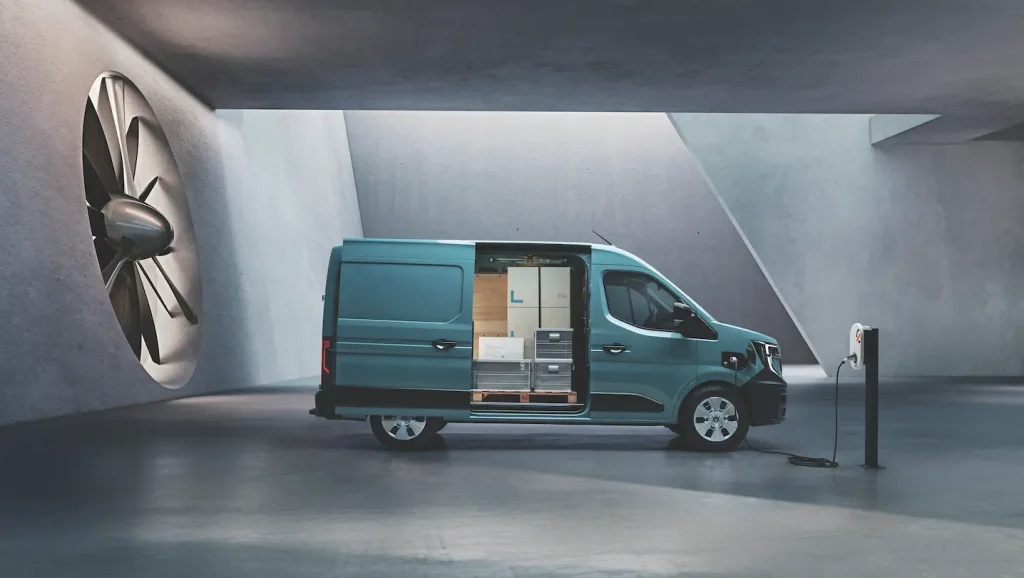
Versatile load carrying
Renault offers the Master panel van range in two lengths and two roof heights. The load length stretches to 3,855mm, an increase of 100mm, and is complemented by a maximum load volume of 14.8m3. The load bay is reached via twin rear doors and a nearside sliding door. To ease access for busy operators, the side door width has been increased by 40mm to 1,313mm, wide enough to fit a euro pallet through.
Despite longer load lengths, the shorter wheelbase and redesigned front axle combine to deliver outstanding manoeuvrability, including a 1.5m tighter turning circle.
Cabin comforts
The ‘S’-shaped driver-focused dashboard adds to interior spaciousness and creates a car-like environment with excellent ergonomics. Renault describes the cab as a cockpit that doubles up as a workstation with the middle passenger seat folding down into a desk, the base of which houses a handy slot to store a laptop*.
A 10in touchscreen is standard across the Master line-up to enable the OpenR Link multimedia system that includes wireless Android Auto and Apple CarPlay connectivity.
OpenR Link with Google built-in* is also available as an option. It includes Google Maps, the Google Play App catalogue and voice-controlled Google Assistant.
For Master E-Tech, an Electric Route Planner can increase vehicle uptime for businesses by identifying charging stations, setting charging times and optimising battery use.
A further function of OpenR Link is its ability to integrate controls for conversion equipment into the multimedia system, allowing the driver to operate the equipment from the touchscreen.
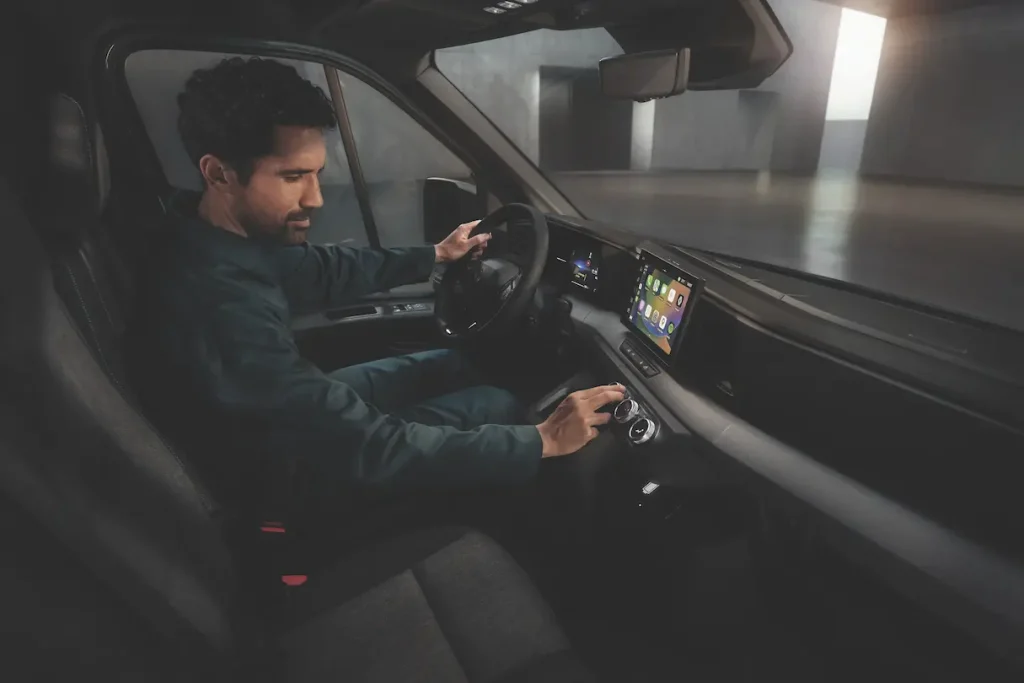
The cabin offers a generous 135 litres of storage space, a 25% increase on the outgoing Master. The van is endowed with up to 20 driver assistance systems to protect occupants, pedestrians and other road users*. The package includes active emergency braking, lane departure warning and driver attention and drowsiness alert.
The price is right
For such an accomplished vehicle, a price tag from £37,500, excluding VAT and including the £5,000 Plug-in Van Grant, undercuts its rivals to make the new Master E-Tech extremely competitive within the UK’s large electric van market.
For businesses not yet ready for electrification, the new Master is also available with a 2.0-litre diesel BlueDCi engine with outputs of 130, 150 or 170hp.
*based on 87kWh E-Tech 100% electric L2H2 4T version. WLTP test data shown for comparability purposes only. Actual real world driving results may vary
depending on factors including the starting charge of the battery, accessories fitted after registration, weather conditions, driving styles and vehicle load
*usable cargo capacity based on 87kWh E-Tech 100% electric L2H2 4T version.
*follow road safety regulations when using mobile office. It is the driver’s responsibility to stay alert, drive safely and always be in control of the vehicle.
*available as standard on Extra and optional on other versions. Google, Google Maps and Google Play are trademarks of Google LLC
*it is your responsibility to stay alert, drive safely and be in control of the vehicle at all times. Driver assistance features have speed and other limitations and should not be solely relied on. For more information, please refer to the owner’s manual or visit renault.co.uk/safety.

